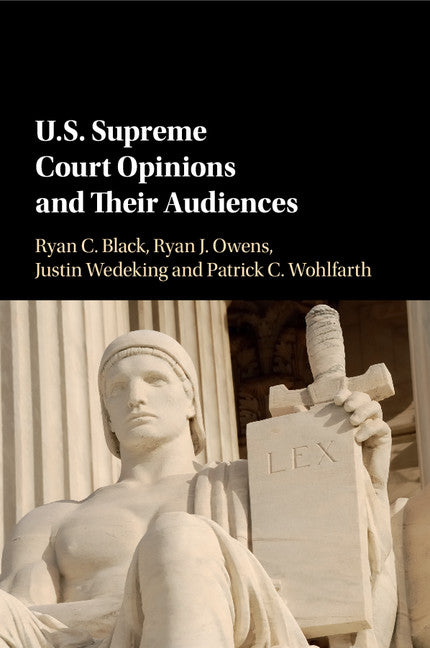Freshly Printed - allow 8 days lead
Couldn't load pickup availability
US Supreme Court Opinions and their Audiences
An investigation of how US Supreme Court justices alter the clarity of their opinions based on expected reactions from their audiences.
Ryan C. Black (Author), Ryan J. Owens (Author), Justin Wedeking (Author), Patrick C. Wohlfarth (Author)
9781316502105, Cambridge University Press
Paperback / softback, published 11 May 2017
194 pages, 25 b/w illus. 13 tables
22.9 x 15.2 x 1.1 cm, 0.27 kg
'For generations political scientists have studied who wins and loses in front of the US Supreme Court, focusing on dispute resolution rather than opinions the justices write. In US Supreme Court Opinions and their Audiences four leading political scientists study how the justices manipulate the clarity of opinions in light of their intended audiences, including lower courts, agencies, the states, and the people. This book is a must-read for any empirical legal scholar interested in taking law seriously in positive studies of Supreme Court behavior.' Andrew Martin, University of Michigan
This book is the first study specifically to investigate the extent to which US Supreme Court justices alter the clarity of their opinions based on expected reactions from their audiences. The authors examine this dynamic by creating a unique measure of opinion clarity and then testing whether the Court writes clearer opinions when it faces ideologically hostile and ideologically scattered lower federal courts; when it decides cases involving poorly performing federal agencies; when it decides cases involving states with less professionalized legislatures and governors; and when it rules against public opinion. The data shows the Court writes clearer opinions in every one of these contexts, and demonstrates that actors are more likely to comply with clearer Court opinions.
1. Introduction
2. A theory: using opinion clarity to enhance compliance and manage public support
3. Estimating the clarity of Supreme Court opinions
4. Supreme Court opinions and Federal Circuit Courts
5. Supreme Court opinions and Federal Agency implementors
6. Supreme Court opinions and the States
7. Supreme Court opinions and the secondary population
8. Establishing compliance as a function of clarity
9. Conclusion.
Subject Areas: Courts & procedure [LNAA], Law & society [LAQ], Jurisprudence & general issues [LA], Law [L], Politics & government [JP]


